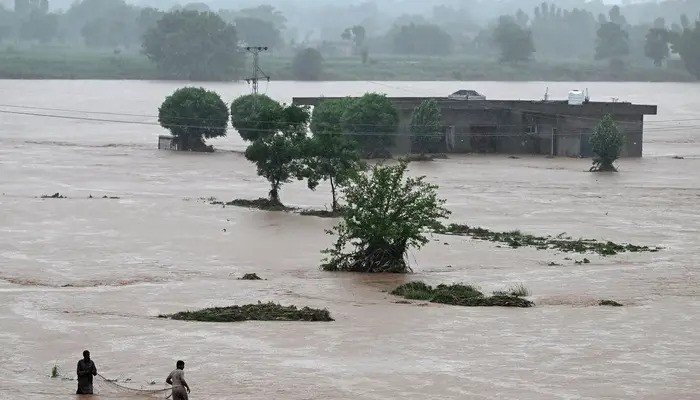Monsoon floods have devastated parts of Pakistan, killing at least 57 people, including many children, over the last two days. Relentless rainfall since Wednesday has submerged rural and urban areas in Punjab, the country’s most populous province. The disaster has revived concerns over climate change, as the country battles yet another extreme weather event.
Rain Lashes Punjab
Heavy downpours hit multiple regions, causing sudden urban flooding and rising river levels. Both cities and countryside areas were affected, with villages completely inundated. The National Disaster Management Authority (NDMA) confirmed most of the deaths occurred due to collapsing buildings. Of the 57 fatalities, 24 were children.
The rain also caused major disruptions in Rawalpindi and surrounding areas. Streets turned into flowing rivers. Homes and shops were flooded. Debris-filled water pooled across roads, stalling traffic for hours. Power outages lasted up to 19 hours in several neighborhoods, leaving families without electricity and clean water.
Read: Army Leads Nationwide Rescue Mission Amid Worsening Floods
Helplessness and Loss
Residents in flood-hit areas described scenes of panic and helplessness. In Chakwal, one of the worst-affected districts, small farmers saw their crops and homes washed away.
Malak Jamil, a 56-year-old farmer, watched floodwaters destroy everything he owned. “It happened so fast,” he said. “I’ve lost over $6,000 worth of crops. That’s more than my yearly income. I don’t know how I’ll recover.”
Asim Ali, a gardener from Jabbar Darvesh near Islamabad, lost his home when one wall collapsed under the force of the water. “We’ve never experienced anything like this before,” he said. His family of eight is now homeless.
Rescue Operations in Full Swing
With many areas cut off, the military deployed helicopters to rescue over 100 stranded people. According to state media, evacuations continued through Thursday. Local authorities advised residents in low-lying areas to evacuate immediately if orders are issued.
In Islamabad and Rawalpindi, emergency sirens blared as the main flood channel swelled 22 feet above its normal level. Authorities declared a public holiday to allow emergency services to focus on relief and rescue work. Government offices were shut down to minimize movement.
Electrocution and Warnings
Some deaths were reported due to electrocution. Officials urged people to avoid touching damaged electrical lines or appliances soaked in floodwater. The provincial government in Punjab also released public safety advisories, urging caution during the ongoing rains.
Impact on Children and Health Risks
The United Nations Children’s Fund (UNICEF) warned that the floods pose severe risks to children. “As monsoon rains continue and waters rise, children face life-threatening risks from drowning, collapsing homes, and waterborne diseases,” the agency said.
With sanitation systems overwhelmed, the risk of disease outbreaks is growing. Medical teams are on standby, especially in areas with reported contamination of drinking water sources.
Climate Change Behind Extreme Weather
Climate experts again pointed to global warming as a key factor behind the intensifying monsoon floods. According to scientific models, human-induced climate change has strengthened the monsoon system, making rainfall more frequent and more intense.
The 2025 floods follow a troubling trend. In 2022, Pakistan saw its worst monsoon disaster in decades. Over 1,700 people died, and millions remained displaced for months. That year’s deluge covered one-third of the country and severely damaged infrastructure and agriculture.
Melting Glaciers Add to the Threat
Punjab’s disaster management officials noted another alarming factor: the accelerated melting of glaciers in northern Pakistan. This melt, intensified by recent heatwaves, adds more water to rivers already swollen by rain, increasing the risk of flash floods.
Hope for a Break
The Pakistan Meteorological Department said rainfall may ease by Friday, offering some relief. However, continued monitoring is crucial, especially in regions downstream of major rivers. Rescue efforts remain ongoing, with many areas still inaccessible by road.
As Pakistan braces for more extreme weather in the coming months, officials stress the need for long-term climate adaptation strategies, better infrastructure, and enhanced early warning systems.
Follow us on Instagram, YouTube, Facebook,, X and TikTok for latest updates
